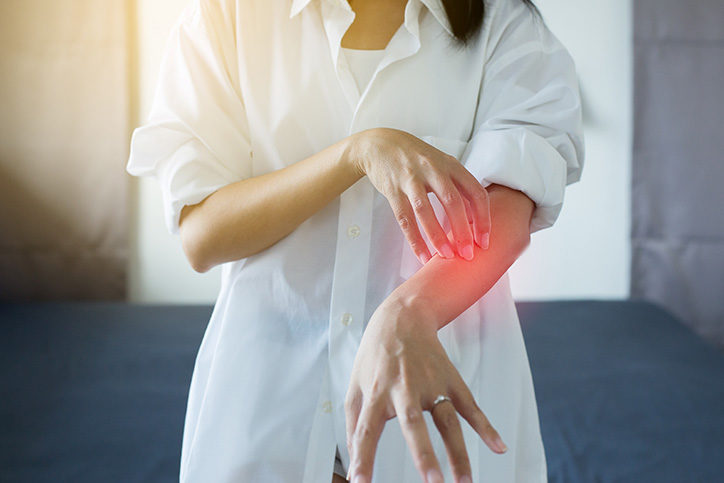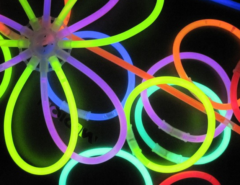At the Maryland Poison Center (MPC), we talk a lot about poisons that are swallowed. But, did you know we manage other types of poison exposures, too? Let’s look at other ways a person can be exposed to a poison, such as dermal (skin) exposures. Skin exposures are usually unintentional. The MPC manages approximately 2,000 such exposures each year. Below, we review what to do if a skin exposure happens, as well as some common products we receive calls about at the MPC.
First Aid for Skin Exposures
If you or someone you know gets a product on their skin, follow these first aid steps:
- Remove any contaminated clothing and jewelry.
- Rinse the skin with lukewarm, not hot, water for 10 minutes.
- Call the poison center at 1-800-222-1222.
Common Products Linked to Skin Exposures
Household Cleaning Products
Common household cleaning products we receive calls about include:
- Bleach
- Disinfectants
- Laundry products
- All-purpose cleaners
In many situations, getting a household cleaner on the skin will not cause any symptoms. Some will cause minor skin irritation or redness. These cases can be managed by rinsing the skin with lukewarm water for 10 minutes. The redness should go away in a few hours.
However, some cleaning products are more harmful if they get on the skin. These products can cause redness, pain, and burns. Such products include:
- Toilet bowl cleaners
- Drain openers
When cleaning, be careful not to splash or spray cleaning products onto your skin. When diluting or moving these products, do so slowly to help make sure they don’t splash onto you.
Cosmetics and Personal Care Products
Some common cosmetic and personal care products we receive calls about include:
- Hand sanitizers
- Creams, lotions, and makeup
- Soap
- Perfume
Although these products are meant to be applied to the skin, sometimes they can cause unwanted effects, including redness and irritation.
When using a new product, do a patch test first to test the product on a small section of skin before applying it to a larger area.
Herbicides and Pesticides
The MPC receives many calls about different herbicides and pesticides, including insect repellents and lawn care products.
Insect repellents are meant to be applied to the skin,but can cause unwanted effects if used in the wrong way. Apply insect repellent to all skin not covered by clothing. When applying repellent to the face, first spray it onto the hands, then rub it onto the face. For more information, read our previously published Insect Repellent blog post.
Before using herbicides or pesticides on your lawn or garden, read the label and follow the directions. When using these products, wear long sleeves, long pants, gloves, protective eyewear, and closed-toe boots. This will keep the product from getting directly on your skin. Be sure to remove and wash the clothes immediately after you are done. Do not use these products when it is windy, because wind could cause the product to blow back onto you. With prolonged contact, these products can be absorbed through the skin and cause mild symptoms such as nausea and vomiting. Other products can cause allergic reactions such as a runny nose and sneezing.
Finally, products used to kill rats and/or mice must be used according to the package’s instructions. After using these products, wash your hands with soap and water. These products should be stored up, away, and out of sight so that children and pets can’t get into them.
Chemicals
Common chemical skin exposures that the MPC receives calls about include:
- Acids
- Alkali
- Boric acid
Chemical exposures on the skin usually happen in the workplace. These products are stronger than what you would find in a home and can cause severe burns to the skin. When using chemicals such as those listed above, make sure to wear proper protective clothing or equipment. Always follow all safety guidelines put in place by your employer or as listed on the product’s packaging.
Topical Preparations
Common topical preparations that the MPC receives calls about include:
- Diaper rash creams
- Camphor containing products (e.g., vapor rub)
- Muscle and arthritis rubs
- Hydrogen peroxide
Diaper rash creams are the most common products in this category; most exposures are from children getting into the product. Diaper rash cream is commonly left out in a child’s reach. Often times, the child will paint themselves and the walls with the creams.
Like other products mentioned here, topical preparations are meant to be applied to the skin. But, they can be used in the wrong way, in the wrong amount, or by the wrong person and cause irritation. Ensure these products are stored up, away, and out of sight from children.
If you suspect that you or someone else has experienced an unwanted skin exposure or a reaction to a product, call the poison center after performing the above first aid steps. We are open 24/7/365. The call is free and confidential. You can always reach a specially trained pharmacist or nurse by calling 1-800-222-1222.





Leave a Reply